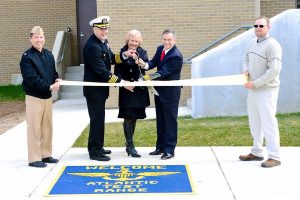
Capt. Jason Hammond, NAS Patuxent River commanding officer, Leslie Taylor, executive director of the Naval Air Warfare Center Aircraft Division, and Rob Vargo, director of the Atlantic Test Ranges, prepare to cut the ribbon for the new high-security addition. Cmdr. Grant Watanabe, NAS Public Works officer, and John Wysong of building contractor G-W Management Services hold the ribbon. (Photo: Adam Skoczylas)
The long-awaited ribbon cutting for a new high-security operations center at the Atlantic Test Ranges (ATR) took place March 27 before a group of Navy officials and distinguished visitors at Naval Air Station Patuxent River.
Leslie Taylor, executive director of the Naval Air Warfare Center Aircraft Division, wielded the giant ceremonial scissors for the opening ceremony along with Rob Vargo, ATR director and Capt. Jason G. Hammond, NAS Patuxent River commanding officer. Cmdr. Grant Watanabe, NAS Public Works officer, and John Wysong of building contractor G-W Management Services, LLC, held the ribbon.
“Threats are changing faster, and adversaries are gaining on the capabilities that the Navy has,” Taylor said. “We must get better faster, and this facility will help us to do just that.”
The 17,000 square-foot, two-story addition to the ATR headquarters building greatly expands the Navy’s ability to test multiple aircraft and onboard systems simultaneously, especially those requiring elevated security levels, Vargo said.
“This doubles our capacity for classified testing with special security requirements and increases our capacity at all security levels by at least 30 percent,” he said.
The new addition, which started construction in 2016, enhances ATR’s capability to conduct extended flight tests, as well as its capacity to support networked integration with other airborne assets, ships at sea, ground test and simulation facilities, and computer-generated environments.
Among the new programs expected to conduct flight tests from the operations center are the MQ-25A unmanned carrier aircraft, CH-53K heavy-lift helicopter, Next Generation Jammer on the EA-18G Growler and conformal fuel tank upgrades for the F/A-18 Super Hornet.
While the new building’s first floor contains office space and conference rooms, the operations center on the windowless second floor comprises four reconfigurable, multipurpose mission test cells, along with two secure conference rooms. Employees will move into the new structure this spring, and testing from the operations center should begin this summer.
Three of the test cells will be outfitted as mission control rooms, adding more capacity and capability to the 10 existing project engineer stations (PES) in the main ATR headquarters building, according to Joe Eversole, ATR’s Project Manager.
One test cell will be dedicated to the MQ-25A Stingray, the next generation unmanned carrier aircraft. “We can support them at this facility with specific shielding against electromagnetic interference and put their aircraft control team close at hand during test,” he said.
The new addition was built under the direction of the Navy Facilities Engineering Command by G-W Management Services, LLC, of Rockville, Maryland, at a cost of almost $11 million, Eversole said. He estimates the building cost will be paid back in less than two years through money saved by reducing expensive delays from scheduling conflicts and limited facilities.
“The Navy’s focus now is on speeding up execution,” Vargo said. “If we were a bottleneck, we would slow them down. With this new capacity, we won’t be.”
Pax River Commanding Officer Capt. Hammond pointed out that the new facility was completed within budget. “This project represents an incredible amount of teamwork between the Public Works Department, ATR and G-W Management,” he said, “and it produces the tools necessary for our incredible professionals to develop and test the systems that will keep us competitive with our peers.”
Vargo said the new facility will allow expanded use of mixed battlespace environments known as live, virtual, constructive – LVC.
LVC “brings all of the pieces into play to support the warfighter in the next generation of exercises, experimentation and wargames,” Taylor said. “This facility will be a significant enabler to LVC.”
All PESs, including those in the new addition, are equipped with ATR’s fifth-generation Real-Time Processing System – RTPS V, said Dennis Normyle, head of ATR’s Telemetry Systems Engineering Section.
“We can handle literally thousands of bit stream parameters from one or more aircraft during a flight test,” Normyle said.
Between new programs in the Navy pipeline and follow-on testing for existing aircraft, the expanded capacity in the new facility will be busy from the start, Vargo said.
In his remarks at the ribbon-cutting, Vargo noted that the old Cedar Point Lighthouse was located just a short distance offshore from the new addition.
“As you know, a lighthouse serves mariners to allow them to safely navigate through the most severe of conditions,” he said. And while the lighthouse is no longer at Cedar Point, ATR still is, he said, and “our mission is to serve our customers and the Naval Test Wing Atlantic aircrews to create a safe and secure test area as they put our weapon systems through the most severe of conditions.”


